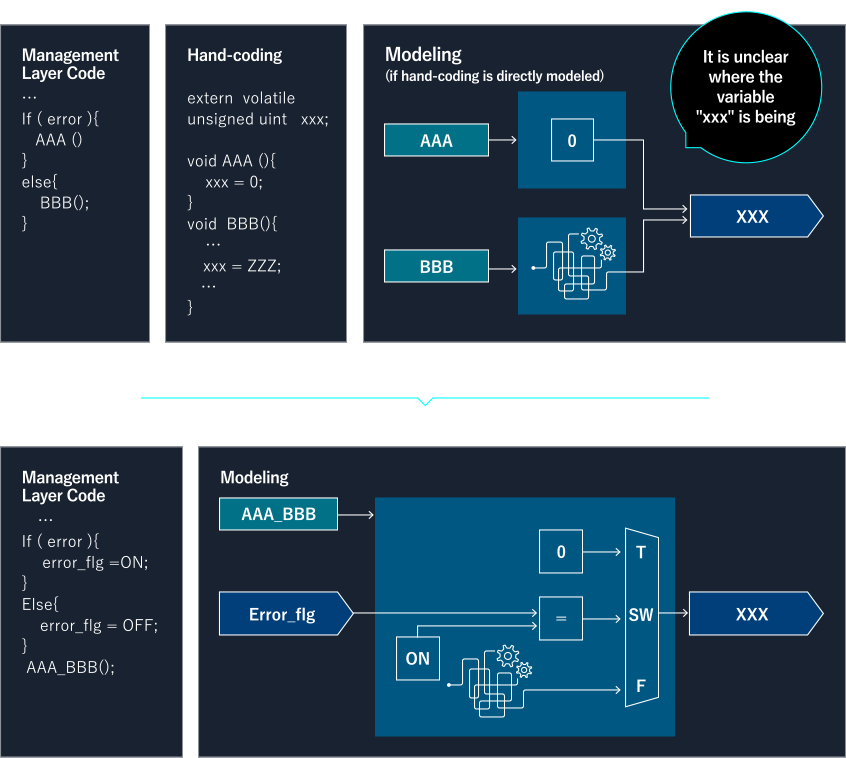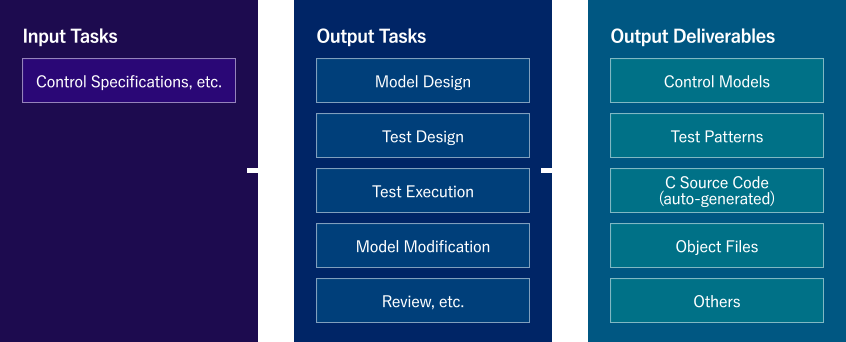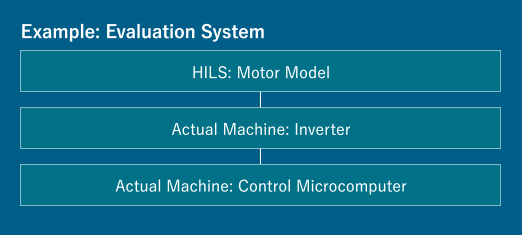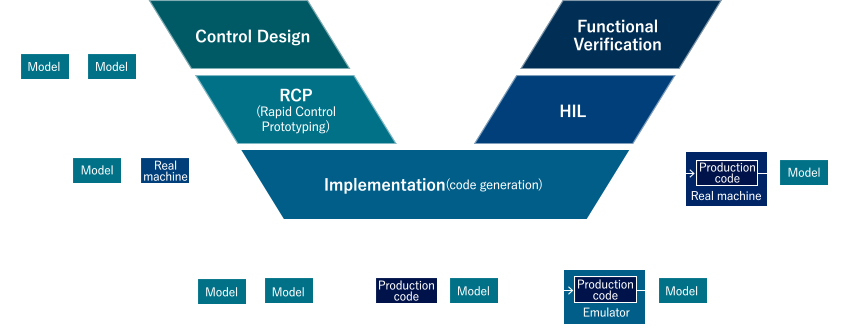Model-Based Development (MBD)
We provide design services that correspond to Model-Based Development (MBD), which is becoming more and more prevalent in the automotive industry.
With the advancement of automotive development, the adoption of MBD, which has features that are not found in traditional development, is accelerating in the automotive industry. To respond to this market change, Sanei Hytechs has developed its own curriculum on MBD and is training engineers. We also provide services that model "existing design assets" not based on MBD and utilize them in subsequent development using MBD.Approaches to Model-Based Development
MBD has the following characteristics:
As development becomes more advanced, particularly in the development of onboard control systems for automobiles, the value created by these MBD characteristics is recognized, and MBD adoption is increasing. To meet these market needs, we have developed our own curriculum on MBD and are fostering the development of engineers.
For more information regarding our efforts related to MBD, please refer to our research and development department.
- It employs expressions that are more precise (less ambiguous) than natural language, which allows for the expression of specifications as models.
- By simulating the model, operational verification can be performed without an actual device.
As development becomes more advanced, particularly in the development of onboard control systems for automobiles, the value created by these MBD characteristics is recognized, and MBD adoption is increasing. To meet these market needs, we have developed our own curriculum on MBD and are fostering the development of engineers.
For more information regarding our efforts related to MBD, please refer to our research and development department.
Model-Based Development Migration Service (Modeling of Existing Design Assets)
In some parts of automotive control systems, "existing design assets" have been implemented without relying on MBD (hereafter referred to as "non-MBD"). However, in recent years, the presence of these existing design assets has increasingly been recognized as a hindrance to simulation and an obstacle to improving design efficiency. Therefore, it is necessary to promptly model these existing design assets.
However, due to differences in the MBD/non-MBD approach and the circumstances of past asset design, it may not be a straightforward process.
For example, the following issues may arise:
To address these various issues, Sanei Hytechs offers a service where engineers with expertise in control theory and MBD technology decipher existing design assets (often C source code) and model them while working closely with the customer.
However, due to differences in the MBD/non-MBD approach and the circumstances of past asset design, it may not be a straightforward process.
For example, the following issues may arise:
- Non-MBD: Control-flow centric, MBD: Data-flow centric
- Necessary information for verification and redesign in MBD is not retained.
To address these various issues, Sanei Hytechs offers a service where engineers with expertise in control theory and MBD technology decipher existing design assets (often C source code) and model them while working closely with the customer.
Reverse engineering of existing design assets
Based on inputs such as source code and existing documentation, we work with our clients to perform the following tasks:
Analyzing and documenting the design
In non-MBD existing design assets, there may be a lack of up-to-date specifications or neglected design documents. In such cases, we read through the source code that is actually in operation (often written in C) and create documentation, such as specifications.Creating a model based on the above
Based on the documentation, we use MATLAB/Simulink from MathWorks to model while working closely with the customer to align with the system's operation.Developing test patterns
We create various test patterns required for the model and perform verification.Establishing a design and verification environment, etc.
We provide the test patterns along with the verification results. Additionally, we construct the necessary environment for design and verification to align with the customer's environment.Clarification of Data Flow
Example: When multiple functions write to the same variable (named "xxx") from a management layer implemented in hand-coding and then called by functions AAA and BBB.

Designing Control Models
We receive control specifications from clients and use them to design and verify control models. Here are some examples of input and output tasks:
Please leave the development of new control model designs using MBD (Model-Based Design) tools such as MATLAB/Simulink from MathWorks to us.
Based on the control specifications presented by the customer, we conduct design and testing of the control model.
The deliverables include the control model, test patterns, automatically generated C source code, and object files.
Please leave the development of new control model designs using MBD (Model-Based Design) tools such as MATLAB/Simulink from MathWorks to us.
Based on the control specifications presented by the customer, we conduct design and testing of the control model.
The deliverables include the control model, test patterns, automatically generated C source code, and object files.

Case Studies
For example, we design and verify control models for electric drive systems such as motors and inverters.
Here are some design case studies for control models of electric motor/inverter systems.- Please provide us with the control specifications for the motor/inverter system to be developed.
- Based on the control specifications, we will design the control model using tools such as MATLAB/Simulink.
- We will create test patterns and verify the control model.
- We will automatically generate C source code/microcontroller objects from the control model that has passed the verification.
- The automatically generated C source code is equivalent to the control model and performs the same control.
- Based on the generated C source/MCU object from the control model, verification work is performed using the motor on the HILS and the actual inverter.

Development process

![[Image]SANEI HYTECHS](/en/shared/img/logo_w.png)